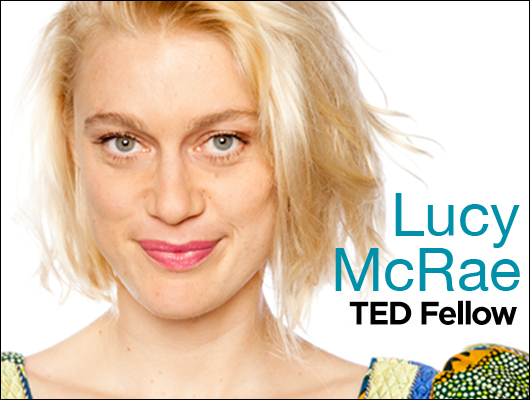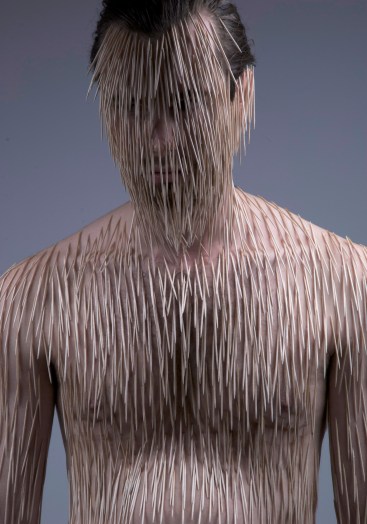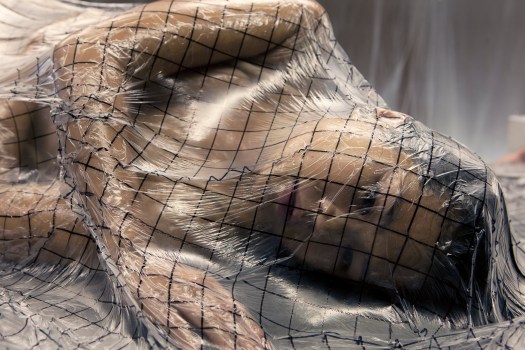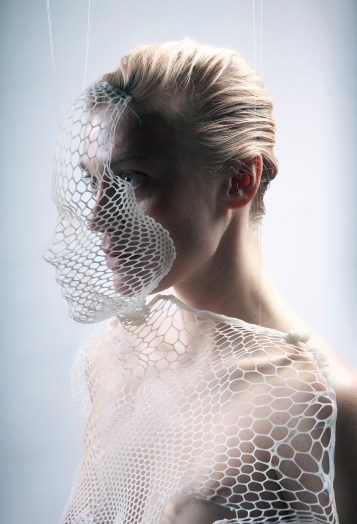Tell us about your history. How did you go from dance to architecture, and from there to “body architect”?
I trained in French classical ballet for 14 years and went on to study interior design at RMIT in Australia. I moved to London (planning to stay for one year and staying for five) and worked in a small architecture practice on experimental, small-scale retail projects and designed a playground in East London. I started a collaboration with a fashion designer friend of mine, returning to the scale of the body, moving away from the scale of buildings. We developed a range of clothes that moved around the body depending on the way the body moved — choreographing fashion like dance.
By chance I was introduced to a creative director at Philips Design, who was leading a far-future design research team. After a very unusual interview (part of which was me falling off the chair), I moved from London to Eindhoven and started freelancing in the Probes team developing wearable technologies that explored emotional sensing. It was here that I met Bart Hess, and from the beginning we clearly had similar interests. One afternoon we decided to find objects from around the office, hold them up to our faces and make a picture; this is how Lucyandbart started. Every Friday, we would meet with the aim of making one image by the end of the day. We got our inspiration from cheap shops, buying hundreds of balloons for example, taking them home and playing with them until they transformed into something else. I then moved to Amsterdam to set up my own studio and am now based in the Red Light District.
Where did the term “body architect” come from?
After freelancing at Philips for a year, I was asked to apply for a full time job (another unusual interview was to occur). I remember standing in the human resources office, wafting my hands around in the air attempting to answer the question, “So tell me Lucy, what are you?” I looked at the interviewer, scrambling for a description that packaged together my background in ballet, architecture and fashion. He gestured towards a white board with a matrix of job descriptions drawn on it and explained that he needed my job title in order to hire me. I left the office and called the programme director Clive van Heerden to tell him: ”I didn’t get the job, I don’t know what I am.” He told me to go back and tell them, “I am a body architect.” I returned the following week, knocked on the door, and said, “I am a body architect.” “Wonderful,” he replied. “You start Monday. Here is the contract.” Having to define myself after seven years was an uncomfortable experience, but being the world’s only body architect gives me the freedom and an unlimited platform to explore and discover what I like.
There’s no way you could have planned for that series of events!
Exactly. I never in my wildest dreams imagined I would be exploring emotional sensing at Philips, or sticking hundreds of toothpicks to Bart’s body, or living in Holland. Each time I have made a transition, it’s been a real surprise. A good friend of mine once said to me, “To the outsider, it makes complete sense what you’re doing,” but to me, sometimes it feels quite chaotic. But somehow it does all make sense.
What are you working on now?
I recently wrote and directed a short film for an Australian skincare brand Aesop, which comes out later this year, and I am currently doing an architecture project for a hotel development in Canberra, Australia. I’ve never done anything like this before: I’m experimenting with ways to transform glass (specifically mirror), and with how architecture can distort the body.
Where do your ideas originate?
I’m inspired by experiences that happen in my immediate environment, and science is always at the root of this inspiration. My process and way of working is seeded by instinct, and my projects are primal responses to what is going on around me at that time.
With the project “Chlorophyll skin,” for example, I was sitting at the kitchen table at midnight watching an animation and this idea popped into my head: “I wonder if I could make a skin that keeps changing color”? I grabbed some glass cleaner spray, some Q-tips and fled to the bathroom with my roommate to see if it would work. I did this for the next four weeks!
One of the things I’m fascinated with is how I can create effects that would normally be made digitally — in a computer or camera — in an analogue way. For example, the architecture project I’m working on I’m looking at how I can build a structure that represents a time lapse? it’s something that you can easily do in Photoshop (or other program), but bringing the idea into the analogue world is a different thing. It’s exciting.
I really enjoy transforming materials and seeing how one thing can become something else. I like to think that I work a little bit like a scientist, making experiments and observations, using my camera as a microscope. I don’t have any idea of what the final outcome will look like, it’s through experimentation that I discover new landscapes. I feel like I have all of these ideas embedded inside of me, and when a conversation or experience aligns with an idea, one is brought to the surface. An idea can come at obscure times of the day or night, in the shower or when I’m sitting still… There is no pattern so far.
Your exploration of the limits and boundaries of the body has moved from the outside in with the idea for the Swallowable parfum, which uses the body as an atomizer. Where did the idea come from, and how will it work?
I was watching a documentary on how technology is shrinking and how, in the future, we will be able to digest sensors that will reprogram biology away from disease and ageing. I became fascinated with how this could redefine and evolve the human body. I collaborated with a synthetic biologist, Sharef Mansy, to create a Swallowable parfum; an artistic provocation created to provoke and ignite discussion between people and to explore the possibilities of what could happen when the cosmetic, pharmaceutical and fashion industries merge. The product hasn’t yet been developed. While it may be someday, for me the priority (and enjoyment) is creating and expressing the idea and provoking how technology may evolve us.
What are your thoughts on age-old body modification and decoration techniques, such as tattooing? How do you feel your work is related or brings it into the present?
I was first introduced to looking at the human skin in a different way when I started working at Phillips. One of the first things we started exploring was tribal scarring, piercing, plastic surgery and tattooing; studying the various different ways the skin has been treated. That research has had a big impact on my work, begging the question how can we transform the skin to become something else? The Swallowable parfum is an example of this transformation of skin; where the skin becomes an atomizer, a platform where something else can happen.
In what ways has being a TED Fellow made an impact on you so far?
I feel very lucky to have been selected and invited to share the TED stage with such incredibly talented and passionate people. I met the most fascinating and wonderful people being consistently amazed by what people are doing and discovering. TED is a pioneering platform that showcases the most exciting things people are doing from the vast fringes of the world. Infinite opportunities and lifelong friendships has been my TED experience so far…




Comments (18)
Pingback: Part 4 Project 2 Stage 2, Analyse 3 Pieces of Work | Textile 1 Exploring Ideas
Pingback: Lucy McRae | jadesmith45
Pingback: Biohacker meets Willy Wonka
Pingback: Biohacker meets Willy Wonka: Lucy McRae on the making of the incredible edible music video for Architecture in Helsinki | jr
Pingback: Lucy McRae spins sweet & futuristic music video "Dream a Little Crazy" | TEDFellows Blog
Pingback: Biohacker meets Willy Wonka: Lucy McRae on the making of the incredible edible music video for Architecture in Helsinki | Best Science News
Pingback: Biohacker meets Willy Wonka: Lucy McRae on the making of the incredible edible music video for Architecture in Helsinki | Cherry Wired
Pingback: Biohacker meets Willy Wonka: Lucy McRae on the making of the incredible edible music video for Architecture in Helsinki | BizBox B2B Social Site
Pingback: Biohacker meets Willy Wonka: Lucy McRae on the making of the incredible edible music video for Architecture in Helsinki | Health & Wellness Chicago
Pingback: Como a tecnologia pode transformar o corpo humano? Por Lucy McRae « blog espirito bird
Pingback: ARTIKELEN | Praktijk Research Lucy McRae
Pingback: ARTIKEL | Praktijk Research Lucy McRae
Pingback: ARTIKELEN | Praktijk Research Lucy McRae
Pingback: Almond oil & Avocado Butter for more Beautiful and Healthier Skin Hydroxatone ? The Anti Aging Cream That Works - Revitalizes skin for anti aging
Pingback: Inside-out: Fellows Friday with Lucy McRae - The Society – Entrepreneurs Epicentre